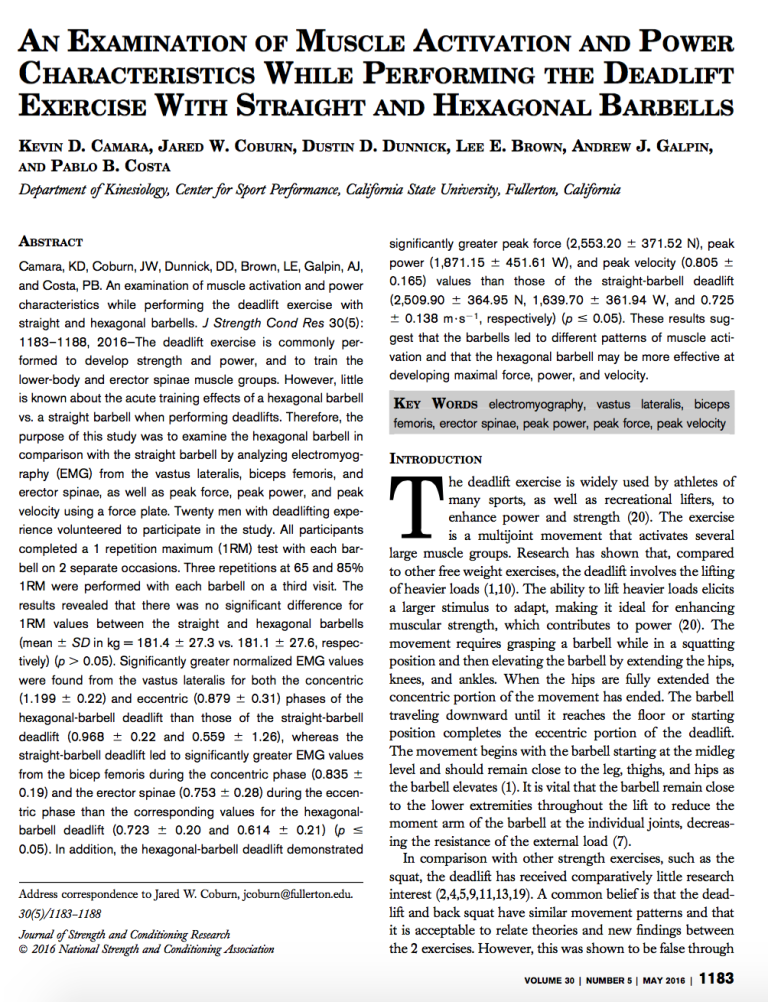A while back, I wrote a post about the positives and negatives of the Trap Bar Deadlift as opposed to a traditional, barbell deadlift (if you missed it, read it here). That article drew quite a bit of attention from fitness and performance professionals and lead to some great conversations.
In that post, I made the argument that for most people, a traditional deadlift is preferable to the Trap Bar (or Hex Bar). This is because on the surface, the trap bar version appears to be more of a quad dominant movement and it’s barbell counterpart. Most people that I work with, have a tendency to be quad dominant, and I am constantly working to make them more hip dominant because of the overwhelming injury data that coincides with quad dominance. While I don’t think that using the barbell over a trap bar is a complete hard, fast rule for all people, but because of the fact that most people struggle with posterior chain weakness and instability, I feel that the barbell deadlift is preferable.
Last month a new study was published in the Journal of Strength and Conditioning Research looking at this exact topic, so it’s important that we look at what the evidence is telling us to better understand the topic instead of just relying on our personal experience. Below are some important conclusions that came from this study:
- There was no significant difference in a 1 Rep Max between the Hex Bar Deadlift and the Barbell Deadlift.
- EMG data demonstrated a significantly higher activation of the Vastus Lateralis muscle with the Hex Bar Deadlift, indicating that it is a more quad dominant movement.
- EMG data demonstrated a significantly higher activation of the Biceps Femoris and Erector Spinae during the Barbell Deadlift, indicating that it is a more hip and posterior chain dominant movement.
- Deadlifts with the hexagonal barbell demonstrated higher peak velocity, peak force, and peak power than deadlifts with the straight barbell, indicating that it may be a better choice for developing speed and power.
What is the practical application?
To start, I’m not surprised that the EMG data indicats that the Barbell version of the deadlift is a more posterior dominant movement. This supports my major argument that, because we want our athletes and clients to be hip dominant, that the barbell version is preferable for most people. But, we can distract some other thoughts out of this EMG study that may persuade some people to the Hex bar category.
Because there is a greater activation of the Erector Spinae with the Barbell Deadlift, athletes or clients who have a history of low back pain may want to error on the side of the Hex Bar version to unload that area of the body. Of course, in that scenario, I would strongly suggest that they supplement this deadlift with other hip movements within their workout.
Aside from the EMG data, what I think is interesting about this study is that their force plate data showed that there was greater peak force, peak velocity and peak power with the Hex Bar Deadlift than the barbell. They concluded that if you are training for speed and power, that this indicates that the Hex Bar modification might be a better fit. As I think through this, I’m not surprised that these numbers are a little higher because the Hex Bar is more in line with the center of mass of the individual, thus making it easier to control under higher speed conditions. Because of the anterior position of the barbell, controlling it with higher rates of speed is more difficult and won’t come nearly as natural for most people.
With all of that being said, I don’t know how many people are using the deadlift to improve Rate of Force Development (RFD) for speed and power. The deadlift is typically much more of a maximum strength movement, and it is my opinion that it should continue to be treated as such. Thus, the velocity and power data doesn’t mean that much to me. If I’m going to train speed and power, I will use plyometrics and/or Olympic lifts.
Overall, this research really just confirms what we already knew or suspected. The Hex or Trap Bar variation of the deadlift is a more quad dominant movement than a Barbell deadlift. But, because of the load placement, it does provide advantages for some people who are in need of modifications to meet their specific needs. I will personally continue to lean on the Barbell deadlift for maximum strength with the ability to modify it as needed with the Hex Bar as needed for the individual. I consider it another tool in my tool box.
To read the research yourself, go to:



Leave a Reply